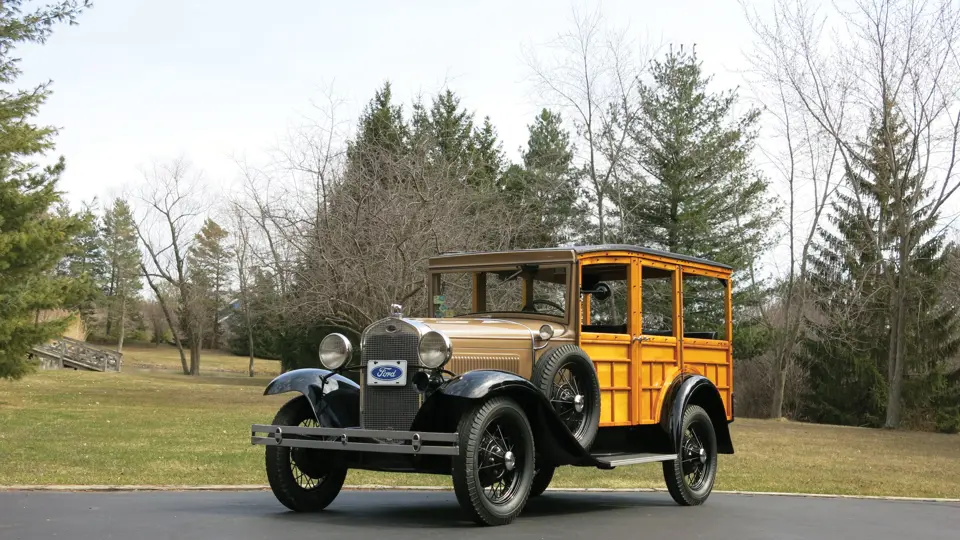 | Auburn, Indiana
| Auburn, Indiana
The year of 1915 saw the one-millionth Model T built and half the vehicles in the world were Model T Fords. By 1923, Ford was producing a new Model T Ford every fifty-nine seconds and that year, nearly 2.3 million Model Ts were built and sold. By 1926, the Model T was becoming antiquated and Chevrolet beat Ford in vehicle sales. After building nearly 15 million Model Ts, Ford discontinued production in 1927.
In an unheard of move, Ford closed its factory for nearly six months to retool for a new model. The new model was to be built at a Ford facility called The Rouge, which previously built parts for the Model Ts that were assembled at Highland Park. The new model was vastly different than the Model T that preceded it and early announcements simply called the car The New Ford.
Soon, the vehicle was named the Model A. Ford chose to use the Model A name again as the new model was such a radical departure from the Model T that he felt the need to start the model alphabet over again. The new Model A was introduced in October of 1927 as a 1928 model. It featured a larger, four-cylinder engine that was coupled to a three-speed, sliding gear transmission which was completely different than the two-speed planetary transmission used on the Model T.
The new Model A engine was roughly based on the Model Ts engine, but was larger in displacement and featured a contemporary distributor ignition, a water pump, and a then state-of-the-art updraft carburetor. Safety was of paramount importance and while the Model T had a transmission brake, the Model A had four-wheel, internally expanding brakes and was the first low-priced production vehicle to be equipped with shatterproof safety glass. Although the chassis was designed by Henry, the body of the new car was designed by Edsel. The new Model As were offered in a variety of contemporary and stylish body designs that rivaled those used on some of the most contemporary luxury cars of the era. They were painted in a variety of rich colors and trimmed with nickel- plated accessories. The Model A was priced between $380 for the roadster and $590 for the four-door sedan and was quite a bargain during this period. Ford Motor Company built the Model A for nearly four years. By 1931 over five-million Model As had been built and sold and Ford was retooling to build another revolutionary vehicle-the new V-8.
This 1930 Model A Ford Station Wagon is an excellent example of one of the most desirable Model A body styles. This “woodie” is a correct and well-preserved older restoration that remains in excellent condition today. It was purchased from the noted Michigan collector Tom McDonald. During the recent ownership, it was selected and used by Ford Motor Company for their 100th Year Anniversary Promotional Tour and exhibited at the 2003 National Ford Dealership Meeting at the Greenbrier Resort in White Sulphur Springs, Virginia.
It is finished in the correct colors of manila brown with black fenders and black wheels. Today, with the exception of a few minor chips and some areas of wear, the older paint remains in good to very good condition. The natural wood finish on the body shows aging, but presents nicely with a mellowed look that is very appealing.
The interior was refinished at the time of restoration in a proper, black vinyl material and today remains in good condition. The top is covered in the correct Cobra, long-grain pattered material and is very clean and undamaged.
It should be noted that most Model A Ford station wagons have reproduction bodies. This example, however, has an original body with mostly original body wood, steel hardware and the proper flooring. It also retains its original Raulang body tag. The body shows no signs of damage with good door fit on all four doors and the rear tailgate. The hood fits the body with proper alignment. The fenders do not appear to have ever been damaged or repaired.
The chassis shows overall signs of cosmetic wear and has not been cleaned or detailed in several years. The engine compartment also shows signs of usage and should be cosmetically refinished. The stainless steel accessories remain in excellent condition. The vehicle is equipped with a side-mounted spare tire, an accessory radiator stone guard and a quail radiator carp.
It is complete with all of the proper and scarce items often overlooked in most Model A restorations, such as the original Houdaille shock absorbers, metal stemmed valve covers, Sparton horn and Zenith carburetor. Overall, this is a very nice and authentic example of a desirable Model A Ford “woodie station wagon.





